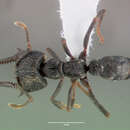Description
provided by Zookeys
Worker. Description. Measurements: lectotype. HL 2.40, HW 2.61, SL 1.80, ML 2.92, HD 1.67, WL 2.79, PnW 1.39, PpW 1.21, PtW 1.18, PtL 0.81, CI 108.7, SI 69.0, MI 111.8, PpI 87.4, PtI 144.9.
HL 2.00–2.58, HW 2.12–2.76, SL 1.55–1.96, ML 2.39–3.17, HD 1.33–1.69, WL 2.43–2.96, PnW 1.17–1.38, PpW 1.02–1.29, PtW 1.00–1.32, PtL 0.67–0.81, CI 104.4–108.5, SI 68.8–74.9, MI 106.9–122.9, PpI 87.2–93.8, PtI 139.5–163.2 (10 specimens measured).
Posterolateral corner of head moderately expanding posteriorly. Posterior face of vertex forming almost right angle with dorsal face on median line of head, so that declivity of vertex on lateral part as steep as on median part. Whole region of vertex finely striated. Eye moderately small. Anterior margin of clypeus straight or weakly convex with long conical setae. Genal tooth of head relatively long, as long as lateral lobe of clypeus. Masticatory surface of mandible almost invisible in full-face view, and width of dorsal surface of mandible almost identical from mandibular shaft to distal portion. Second maxillary palpomere longer than third. First flagellomere (third antennal segment) about 1.2–1.5× length of pedicel (second antennal segment). Strong, deep longitudinal striae regularly impressed on whole central part of pronotal dorsum. Strong, deep longitudinal striae impressed on lateral surface of pronotum. Mesonotum differentiated from propodeum in dorsal view, length slightly shorter than that of propodeum. Metanotal groove shallowly and gently impressed in lateral view. Metapleural gland bulla moderately developed, and propodeal declivity in lateral view almost straight. Petiole widened on posterior 1/3 and gently narrowing anteriorly in dorsal view, anterior margin straight to gently rounded and often edged by thick striae.
Body color black.
Ergatoid queen. Description. Measurements: HL 1.40–1.93, HW 1.46–1.96, SL 1.07–1.47, ML 1.49–2.00, HD 1.00–1.35, WL 1.92–2.56, PnW 0.83–1.11, PpW 0.85–1.13, PtW 0.81–1.07, PtL 0.53–0.70, CI 101.6–108.6, SI 71.6–76.7, MI 96.3–108.8, PpI 96.0–104.4, PtI 149.1–177.1 (10 specimens measured).
Wings vestigial and reduced to small but distinct appendages. Wing sclerites undeveloped. Posterolateral corner of head moderately expanding posteriorly, expansion not differentiated from that in workers. Posterior face of vertex forming almost a right angle with dorsal face on median line of head, so that declivity of vertex on lateral part as steep as on median part. Ventral half of vertex sculptured. Eye small but distinct. Ocelli absent. Anterior margin of clypeus almost straight with long to moderate conical setae. Anterolateral portion of head with short spine. Masticatory margin of mandible almost invisible in full-face view, and dorsal surface on distal portion as wide as that on mandibular shaft. Spatulate seta present on basal side of each basal denticle on masticatory margin of mandible. First flagellomere (third antennal segment) long, about 1.2-1.5× length of pedicel (second antennal segment). Setae on pronotum distinctly spatulate, widened distally with sharp or blunt apex. Metapleural gland bulla moderately developed, not expanding dorsally to propodeal spiracle, so that propodeal declivity in lateral view weakly convex and rounded posteriorly on its ventral 1/3. Petiole relatively long in dorsal view, about 0.8× length of abdominal segment III.
Body color blackish to reddish brown.
Male. Description. Measurements: HL 1.44, HW 2.09, SL 0.62, EL 0.95, WL 3.55, MnW 1.94, CI 145.1, SI 29.6, EI 66.2, MnI 92.9 (1 specimen measured).
Eye moderately large, occupying 0.6× of head length. Ocelli relatively distant from dorsal margin of head in full-face view. Dorsal margin of head in full-face view straight. Both anterior and lateral ocelli small. Lateral ocellus small and distant from eye: distance between these more than 1.5× maximum diameter of lateral ocellus. Posterior face of vertex not clearly differentiated from dorsal face, so that vertex almost continuously rounded. Palpal formula 4,3. First maxillary palpomere flattened and distinctly wider than second segment. Second maxillary palpomere longer than third. Notauli clearly impressed on mesoscutum. Petiole in dorsal view thin, 0.8× as long as abdominal tergite III. Petiolar dorsum covered with shallow, irregular punctures. Abdominal tergum VIII without deep punctures, almost smooth.
Distal portion of abdominal sternum IX smooth and not punctured. Basal ring moderately long, expanding basoventrally. Telomere distinctly extending distally farther than digitus. Basoventral expansion of aedeagus moderately developed basoventrally, longer than dorsal extension. Ventral margin of aedeagus gently convex in lateral view. Aedeagus moderately narrowing distally and distal portion rounded.
On forewing, cu-a located far basal from junction of Media (M) and Cubitus (Cu).
Body color reddish brown to black.
- license
- cc-by-3.0
- copyright
- Masashi Yoshimura, Brian L. Fisher
- bibliographic citation
- Yoshimura M, Fisher B (2014) A revision of the ant genus Mystrium in the Malagasy region with description of six new species and remarks on Amblyopone and Stigmatomma (Hymenoptera, Formicidae, Amblyoponinae) ZooKeys 394: 1–99
- author
- Masashi Yoshimura
- author
- Brian L. Fisher
Distribution
provided by Zookeys
MADAGASCAR: as in Figure 56D.
- license
- cc-by-3.0
- copyright
- Masashi Yoshimura, Brian L. Fisher
- bibliographic citation
- Yoshimura M, Fisher B (2014) A revision of the ant genus Mystrium in the Malagasy region with description of six new species and remarks on Amblyopone and Stigmatomma (Hymenoptera, Formicidae, Amblyoponinae) ZooKeys 394: 1–99
- author
- Masashi Yoshimura
- author
- Brian L. Fisher

